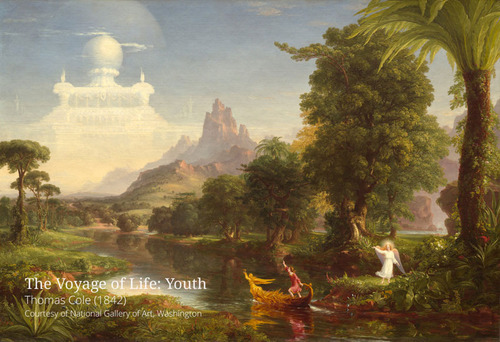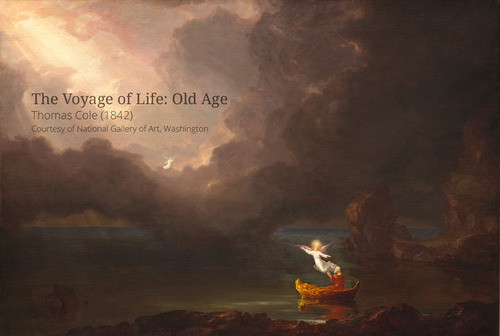Cole's Voyage of Life

Thomas Cole (1801-1848) is largely considered to be the founder of the Hudson River School. The Hudson River School is one of the first artistic movements that were developed in America after the War of Independence. It was an artistic fraternity focused on the American landscape and heavily influenced by romanticism.
Even though artists associated with the movement became active from around 1850, Thomas Cole (1801-1848), an English immigrant to the States, who died a short while before the emergence of the group, served as a strong influence to the young painters of the Hudson River School. Cole painted what he called ”a higher style of landscape”, meaning landscape imbued with metaphorical or allegorical subject matter. As he grew older some of his paintings acquired religious meaning as well, like the series of four paintings called The Voyage of Life, in which Cole portrays the life journey of a man from infancy to old age.

In the first painting, Childhood, the basic elements of the series are introduced. The boat, the angel, the traveler, the river and the landscape. A boat comes out of a cave carrying a happy infant and guided in the river by an angel. The river is calm and the landscape is lush, symbolising in this way the innocence as well as the protected years of childhood. An interesting detail is the hourglass that the figure in the prow of the boat carries.

In the second painting called Youth the traveler is an adolescent now and vigorously takes command of the boat. The angel is left on the shore waving at the young man. He seems to be leading the boat in an airy castle in the sky, symbol of the ambitious but often unrealistic dreams of youth. The landscape remains the same, but we can now see a bit more of it since the young man has more control of his life at this point.

In Manhood the artist presents us with a less joyous image than before. The man is fully-grown, but he is in a precarious situation. The calm river has become a water stream full of rocks. The helm of the boat is gone and the man has lost control of it, a metaphor for his life, hoping for a divine intervention to find salvation. Even though the man can’t see him, the angel still watches over him in the top left corner of the painting. The landscape is quite different and communicates the fear and hopelessness of the traveler.

Finally, in the last painting called Old Age the traveler has reached his destination, the ocean of eternity. The man arrives, in his weather-beaten boat, and for the first time in all of the series he sees the angel. The angel is there to help him move on to other side, which is symbolised by a light in the back of the painting. There is no landscape since this last painting has nothing to do with the corporeal world.
In this series Cole presents his own thoughts about life and religion. Through his ”higher style of landscape” he was able to convey his own thoughts and beliefs while at the same time celebrating the variable and stunning views of the American landscape.
Anastasia Manioudaki is an Art Historian with an MA in Art History from the University of Sussex and a BA in Archaeology & History of Art. Anastasia is currently lecturing on art history and a contributing author for USEUM.